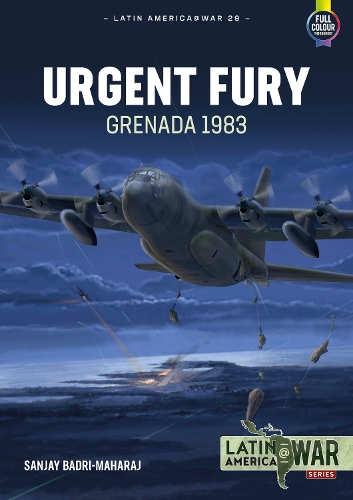
Urgent Fury: Grenada 1983
(Paperback)
Publishing Details
Urgent Fury: Grenada 1983
By (Author) Sanjay Badri-Maharaj
29
Helion & Company
Helion & Company
15th June 2022
15th May 2022
United Kingdom
Classifications
General
Non Fiction
Modern warfare
972.9845
Physical Properties
Paperback
90
Width 210mm, Height 298mm
Description
In 1983, the United States launched a military operation to remove the military junta that had taken over the Caribbean island of Grenada. This operation, code-named Urgent Fury, was held out by the Reagan Administration as a major military success and a victory against communism. In some ways it was. In others it was a foregone conclusion, a victory against a discredited regime with little support internally or externally. Urgent Fury examines the genesis of the Grenadian Revolution of 1979 and the eventual fall of the Gairy Regime and establishing the English-speaking Caribbean's only Soviet-bloc client state, albeit a short-lived one, and the rise and fall from grace of the populist Maurice Bishop. The growth and development of the People's Revolutionary Armed Forces of Grenada is discussed with their strength, weapons and training being examined. Cuba's military and civilian presence is detailed as well as the tension between Soviet ambitions and Castro's agenda to influence the Grenadan Revolution. The fall of Bishop's government, his subsequent arrest and murder, along with the popular backlash that this sparked is discussed and the call for intervention is analysed with attention being paid to the role of the Eastern Caribbean States and their contribution towards legitimizing the US action. The planning, preparation and execution of Urgent Fury is detailed with attention being paid to the role of the Regional Security System and the Barbados Defence Force in this process. Urgent Fury itself is detailed with emphasis on the resistance of Grenadian Forces, despite many not reporting for duty. The political and geopolitical aftermath of Urgent Fury are discussed in conclusion. AUTHOR: Sanjay Badri-Maharaj from Trinidad, received his MA and PhD from the Department of War Studies, Kings College London. His thesis was on India's Nuclear Weapons Program. He has written and published extensively, including two books - The Armageddon Factor: Nuclear Weapons in the India-Pakistan Context (2000) and Indian Nuclear Strategy: Confronting the Potential Nuclear Threat from both Pakistan and China (2018). He has served as a consultant to the Ministry of National Security in Trinidad and was a visiting International Fellow at the Institute for Defence Studies and Analyses, New Delhi. 52 b/w photos, 61 colour photos, 22 colour profiles, 3 maps, 1 table
Reviews
"This well illustrated monograph pretty much captures the essentials for understanding the events of October 1983 in Granada."-- "The Journal of the Air Force Historical Foundation"
Author Bio
Sanjay Badri-Maharaj from Trinidad, received his MA and PhD from the Department of War Studies, Kings College London. His thesis was on India's Nuclear Weapons Program. He has written and published extensively, including two books - The Armageddon Factor: Nuclear Weapons in the India-Pakistan Context (2000) and Indian Nuclear Strategy: Confronting the Potential Nuclear Threat from both Pakistan and China (2018). He has served as a consultant to the Ministry of National Security in Trinidad and was a visiting International Fellow at the Institute for Defence Studies and Analyses, New Delhi. This is his first instalment for Helion.
